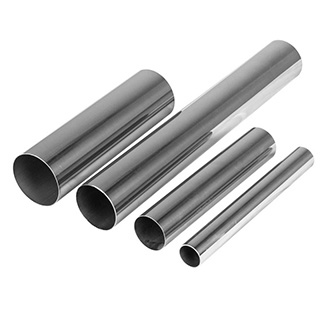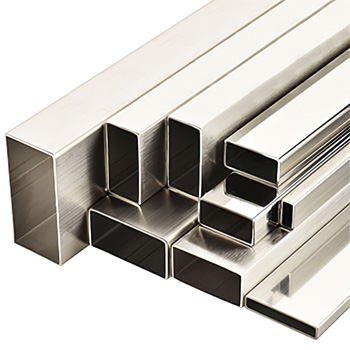Why does stainless steel rust?
Release time: 2021-07-15 14:32:46
Adding chromium or nickel to iron will form a thin, hard-to-action film on the iron, covering the surface. This hard-to-act film is an oxide film. It will cover the steel surface tightly, even if the steel surface is in contact with oxygen in the air, there will be no reaction. In other words, this layer is a dense film formed by oxide, which insulates oxygen. Sometimes different elements such as molybdenum are added according to different uses.
All steel will rust, the key is determined by the material and quality of the protective oxide film. Because some steels contain more than 13% chromium, they have much higher rust resistance than ordinary steels, and they are called stainless steels at this time.

2. The reason why stainless steel "does not rust"
Iron rusts because it easily reacts with oxygen in the air to form brittle red iron oxide. Stainless steel is corrosion-resistant, that is, "no rust" because there is a layer of chromium-rich oxide film on the surface.
3. The main external factors that cause metal rust:
(1) Atmospheric relative humidity At the same temperature, the percentage of atmospheric water vapor content and its water vapor saturation content is called relative humidity. Below a certain relative humidity, the metal corrosion rate is very small, and above this relative humidity, the corrosion rate increases sharply. This relative humidity is called the critical humidity. The critical humidity of many metals is between 50% and 80%, and that of steel is about 75%. The relative humidity of the atmosphere has the greatest impact on metal corrosion. When the atmospheric humidity is higher than the critical humidity, water film or water droplets appear on the metal surface. If harmful impurities contained in the atmosphere are dissolved in the water film or water droplets, it becomes an electrolyte and aggravates corrosion.
(2) Temperature and humidity
Both atmospheric temperature and humidity affect metal corrosion. This has the following main conditions: First, the water vapor content of the atmosphere increases with the increase in temperature; second, the high temperature promotes the intensification of rust, especially in the humid environment, the higher the temperature, the faster the rust rate. When the relative humidity is low, the influence of temperature on rust is not obvious, but when the humidity is higher than the critical humidity, the amount of rust increases sharply as the temperature rises. In addition, if there is a temperature difference between the atmosphere and the metal, condensed water will form on the surface of the metal with a low temperature, which will also cause the metal to rust.

(4) Other chemical factors
The atmosphere contains a lot of dust, such as smoke, coal ash, chloride and other acid, alkali, salt particles, etc., some of which are corrosive, or condensation nuclei of water droplets, are also rust factors, such as chloride is considered It is the "mortal enemy" of corroding metals.
4. What is "stainless steel" for surgical instruments?
In order to maintain high hardness and sharpness, medical equipment mostly uses stainless steel with only 13% Cr as the material. It is a magnetic stainless steel, which is easy to be corroded, has high hardness and sharpness. It has high chemical elements in the oxide film and prevents stainless steel from rusting. It is chromium, copper, molybdenum and nickel.
But it is relatively easy to rust.
5. Specific analysis of "rust" of surgical instruments
(1) Surfaces in contact with blood
The blood contains hemoglobin, which is a compound of iron. The blood contains sodium chloride, which is a strong corrosive compound for all stainless steel. Once these two substances come into contact with the device, they will immediately begin to cause corrosion. Therefore, the surgical instruments must be handled on-site after they are removed from the stage. The more time delays, the more serious the equipment will be corroded and rusted, and the higher the processing cost will be.
(2) Worn surface
The occlusal joints of surgical instruments are the places where the two surfaces are in the closest contact. With each opening and closing operation, the mechanical abrasion of the two surfaces will be aggravated once, that is, the oxide film protective layer will be destroyed once. For frequently operated surgical instruments, this kind of mechanical wear cannot be avoided. Once the protective oxide film is damaged, the device will "rust". Therefore, the joints of the equipment must be the most prone to rust. Moreover, the lower the grade of stainless steel, the worse the quality of the workmanship, the weaker the oxide film protective layer, and the faster the equipment will "rust".
(3) Lack of protection surface
The occlusal joint of surgical instruments is undoubtedly the surface that needs most protection. Whether it is manual or machine automatic lubrication, the purpose is very clear: the first is to isolate the dry surface of the equipment from the air and other harmful chemicals to avoid chemical oxidation; the second is to lubricate the mechanical contact parts to reduce mechanical wear. For the oiling and wiping of other surface parts of the instrument, it is mainly the first effect.
6. Why does rust "infect"?
When a rusted surface touches another surface that is not rusted, "rust", that is, brittle red iron oxide, will adhere to the smooth surface. At this time, the "rust" is only a stain. If you wipe it with a cloth immediately, "Rust" can be removed. But in fact, it is often impossible to deal with it in time. Then, the residual moisture between the uneven iron oxide particles and the smooth surface creates a humid environment. As mentioned above, the protective oxide film on the smooth surface is covered by the chemical electrolyte. Destroyed, the equipment began to rust. This is what we call "rust" is contagious.
Therefore, to minimize the “contagion” of “rust”, in addition to the on-site treatment of the instruments, before cleaning and disinfecting the instruments, the rusted instruments must be singled out for separate treatment, and the other intact ones The instruments are placed in the washer-disinfector for processing.
The correct and timely classification of instruments is an important step to protect instruments and ensure the quality of cleaning.